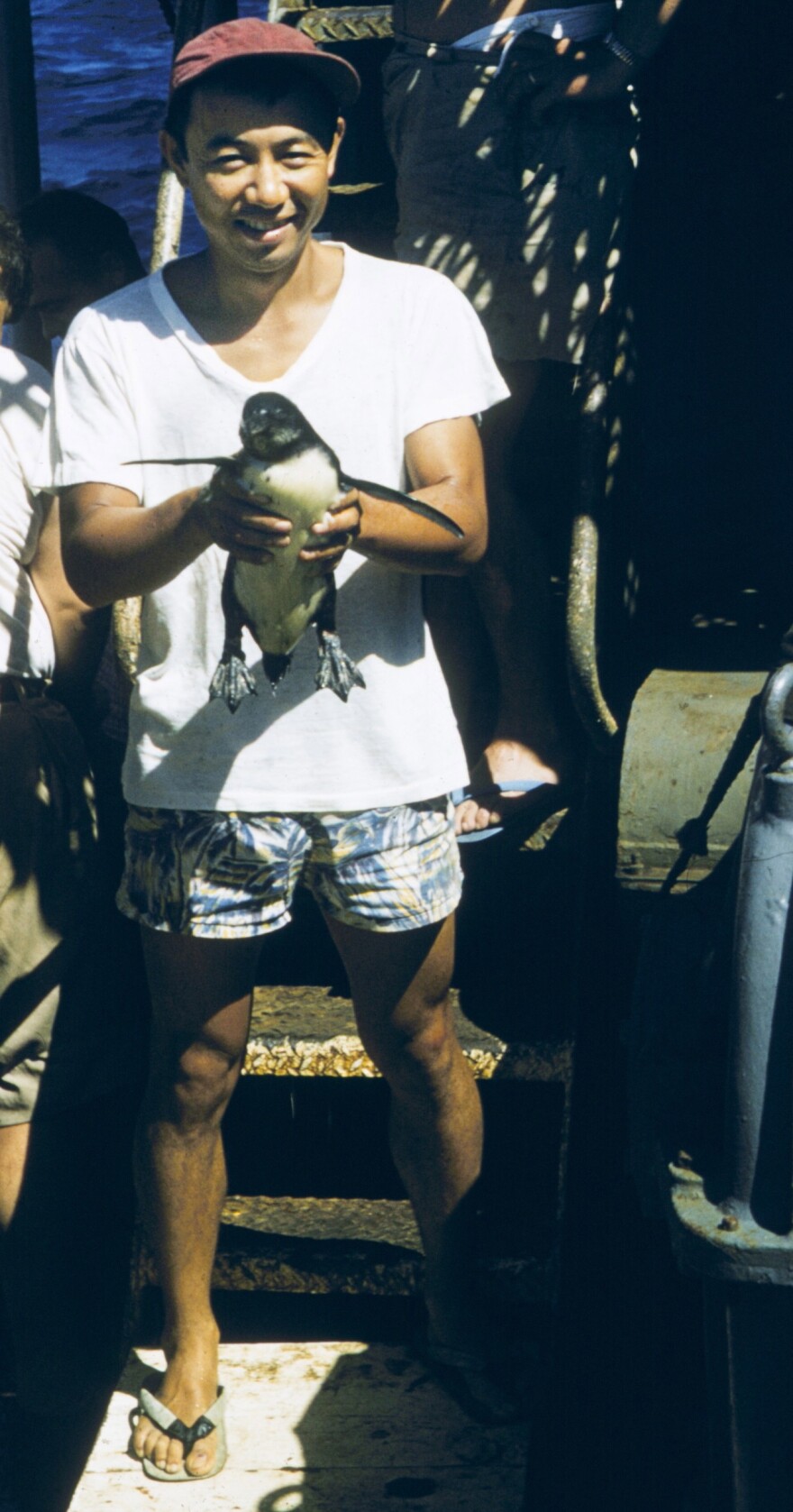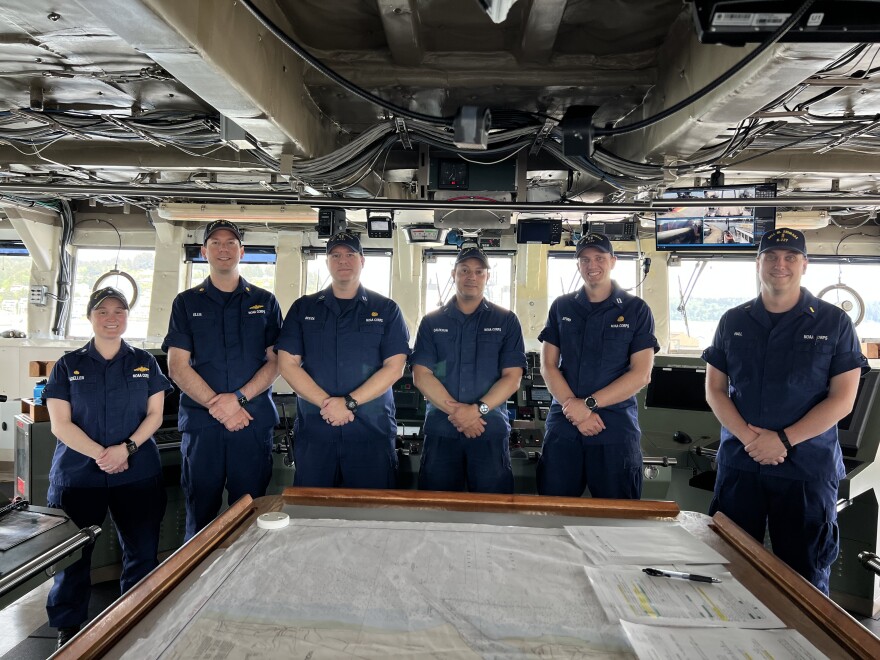When living on a research vessel, nothing stays still.
Not the mug of chai placed on a vinyl-covered mess hall table. Not the sample of plankton left on a stainless steel lab bench. Not the water that sloshed around in the bottom of a shower.
Especially not time.
That’s why the crew and officers on the Bell M. Shimada research vessel worked as a team and lived as a family, as they helped scientists onboard seek answers from the ocean.

The crew worked demanding 12-hour shifts.The officers drove the ship non-stop through weather and complicated channels near Newport, Oregon.
“Before coming out to the Shimada, I hadn’t been out to sea more than just a couple weeks,” said Jonathan Witmer, a survey technician with the National Oceanic and Atmospheric Administration or NOAA.
Witmer and others stay out at sea more than 220 days a year, not all in a row, which means a lot of time away from family and land. However, the crew and officers said they don’t mind. They stay onboard this ship because of its science-based mission and the second-family they’ve made living below deck.
“We’re in a workplace where, when most people go to work, they only have to see those people for a certain amount of time. Then, they get to go home and reset. Here, you live with these people. You become more forgiving,” he said.
People on board the Shimada seek a different reset button.
Take an organized cornhole tournament.

Teams of two, including officers, crew and scientists, tested their skill at tossing bean bags at least 30 feet into a small hole cutout on a wooden board. The first to score 21 points, without going over, won. Any bean bags tossed overboard, a distinct possibility when playing on the 44-foot high flybridge, would have resulted in an automatic disqualification.
Players strictly adhered to the official rules. A dispute in the semifinals was resolved by instant messaging the National Cornhole Association website.
Other crew members released stress by duking it out on the chessboard each night in the mess hall, quietly contemplating moves as people grabbed snacks. The mess hall offered many types of munchies that people might crave, from gallons of ice cream to Flamin’ Hot Funyuns to an ever-rotating salad bar.
Often at night, people piled into the ship’s six-recliner theater to watch movies during off hours, or when the ship traveled between sampling stations, sometimes a 20-hour commute. Moviegoers often opted for charming, sometimes campy films, including the entire “Pitch Perfect” series.
While the atmosphere was fun at times, work always took precedence.
“It’s a hard lifestyle that’s maybe not for everybody,” said Cmdr. Amanda Goeller. “There isn’t anybody that isn’t an active member of getting the operations done every day.”

On this voyage, the scientists aboard the Shimada surveyed the Northern California Current ecosystem. Scientists hope to open up the ocean’s black box a tiny crack. With each study, these scientists onboard continue to unravel the mysteries of the deep: the physical condition of the ocean, how sea life survives, and what a changing climate could mean for the future.
That research takes time. The Shimada can stay on the ocean for around 40 days at a time, although the ship doesn’t stay at sea for much longer than three weeks, said John Wolfston, the ship’s lead engineer. Each voyage is limited by the amount of food the ship can stock.
In addition, the ship basically operates like a small city – making water, feeding crew, incinerating trash.
“It’s a city that can sink,” Wolfston said.
Moreover, the ship carries 100,000 gallons of fuel, Wolfston said, and uses anywhere from 1,500 to 2,500 gallons of fuel per day.
Although the ship fuels at port before leaving, the engineering team brought everything it needed to fix anything that might brake, while maintaining and monitoring the rest of equipment that runs the ship.
“It’s about 90% calmness and 10% ‘oh crap,’” he said, of most ship repairs.

However, each day of the voyage the 208-foot Bell M. Shimada quietly moved through the water to leave sea life undisturbed and measurable, said Roger Hewitt, the assistant center director for NOAA’s Southwest Fisheries Science Center.
“In the last 30 or 40 years, fisheries science has moved more and more to using active acoustics to measure fish abundance near the bottom of the ocean or in the middle of the water column,” Hewitt said.
Active acoustics means that instead of dragging tools and listening for noise, the ship sent out a signal to ping off whatever was below, like echolocation, which is a technique often used in the animal world by dolphins and bats. The acoustics array on the Shimada is one of three such systems worldwide.
In addition, the ship's design lessened disturbances for sea life with a welded steel and aluminum hull, which minimized bubbles generated by the ship. The engines and generators were mounted on shock absorbers. Walls were thickly insulated.
“So ultimately it's a very, very quiet ship,” Hewitt said.
So quiet, compared to other ships, that the first time Hewitt went onboard to test equipment, he didn’t realize the Shimada had left the San Diego pier.
“I was in my state room. Then, I went downstairs, and things were going by fairly fast,” he said. “We'd gotten under way, and I didn't even know it.”
With envelope-pushing equipment, this ship followed in the footsteps of its namesake, fisheries biologist Bell M. Shimada, an internationally-known scientist.

Shimada, born in the United States, was imprisoned in a Japanese internment camp in Minidoka, Idaho, in 1942. At the time, he had been studying fisheries at the University of Washington. A year after his imprisonment, he enlisted in the U.S. Army.
Among other research gigs after the war, Shimada worked for the Pacific Oceanic Fisheries Investigations in Honolulu, Hawaii, where he often went to sea on research vessels.
He then moved to the Inter-American Tropical Tuna Commission, where he made his name studying Pacific tropical tuna stocks, leading early studies of tuna feeding patterns, distribution and spawning.
While en route to conduct more surveys of Pacific tuna, Shimada’s plane crashed near Guadalajara, killing Shimada, 36, and fellow researcher Townsend Cromwell, 36, after whom a now decommissioned NOAA vessel was named.
In 2007, a group of five freshmen from Marina High School in Huntington Beach, California, nominated Shimada as this ship’s namesake.
Shimada’s children, Julie and Allen, attended the christening ceremony. Allen, who now works for NOAA, wrote to the ship’s first commanding officer after the ship’s first voyage to San Diego.
“Today, everything is shiny, bright and new again,” Allen Shimada wrote. “Bell Shimada could not have imagined a finer legacy than the shared experiences of shipmates leading to this day, and new ones in the days and weeks to Commissioning Day and over the years to come.”
And many shipmates have since shared experiences on this vessel.
Three current crew members took the Shimada on its maiden voyage. In the naval world, they’re known as plank holders or plank owners: Bruce Knoepke, chief bosun; Matt McFarland, lead fisherman; and Goeller.
The plank holders saw the ship built in Mississippi, Goeller said. Everything on the boat had to be carried on board, a procedure known as the initial outfitting list.

“Think about every spoon, every pillow, every block. Everything that ever needed to come on the boat, we had to organize and assess,” Goeller said.
Then, the crew brought the Shimada through the Panama Canal so it could conduct research surveys on the West Coast. For all of the original crew, driving through the Panama Canal at night marked a highlight of their time onboard.
“That entire experience, I’ll never forget,” McFarland said around 12 years later.
The work isn’t easy. Crew members could quickly make more money on commercial oil tankers, Hewitt said.
“Right now, they're having a hard time staffing these (research) ships because there's a lot of demand for seagoing people,” Hewitt said. “A lot of them work for NOAA because they like the mission, which is why they would rather work on a vessel that's out there assessing how many fish there are and how many can be sustainably caught as opposed to lugging oil around or cargo around.”
Those on board the Shimada enjoy its unique culture, often cited as “Shimadatude,” said Lt. Cmdr. Justin Ellis.

“Every ship has a personality,” Ellis said. “People come and go. Captains come and go. Chief engineers come and go. Here, it’s just a pleasant, professional, can-do attitude that has pervaded overtime. It’s an even-keeled ship.”
The survey trips might seem long at the time, but the days pass by quickly because all on board work to help the science crew get the information they need, he said.
Moreover, Ellis said, the ship's crew and officers take great pride in the success of the scientists’ work. In addition, he said, it’s how the crew helps the fishing communities where they live.
“We’re not all scientists. We don’t all understand fisheries biology. We don’t all know about copepods and plankton. But everyone that works on this ship has chosen to work on a research vessel,” Ellis said. “The vast majority, if not all, are here because they feel good about the work they’re doing.”
The work, Ellis said, is time well spent.
⬙
Read more in this series:
Part one: To unravel some of the ocean's mysteries, scientists head to sea
Part two: Watching for whales – and their food
Part three: Growing phytoplankton to learn more about the ocean's food web
Copyright 2022 Northwest News Network. To see more, visit Northwest News Network. 9(MDAyMTQyNzY5MDEyNzEzNTYyNDliZTBiOA004))


